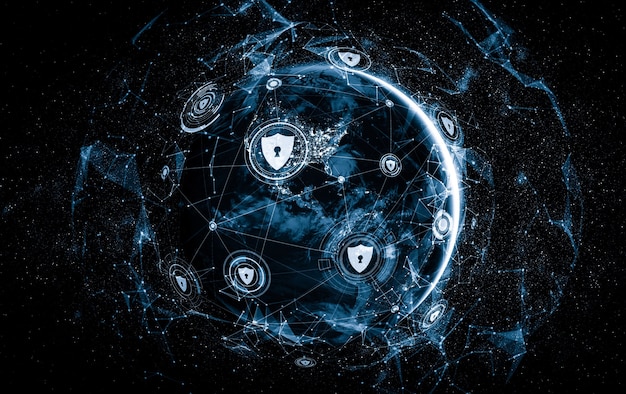New Cybersecurity Act: Key Provisions & US Citizen Protection

The proposed New Cybersecurity Act aims to strengthen national cyber defenses, mandate information sharing, and enhance protections for critical infrastructure and citizen data by establishing clear reporting requirements and increasing federal oversight in a rapidly evolving digital threat landscape.
What are the key provisions of the new Cybersecurity Act and how will it protect US citizens? This question resonates deeply in an era where digital threats evolve with unprecedented speed, touching every facet of life from personal data to national infrastructure. Understanding the intricacies of this legislation is crucial for navigating our increasingly interconnected world.
Understanding the Landscape of Cyber Threats in the US
The digital age, while offering unparalleled connectivity and innovation, has concurrently opened new frontiers for malicious actors. Cyber threats are no longer abstract concepts; they manifest as tangible risks to national security, economic stability, and individual privacy. From sophisticated state-sponsored attacks targeting critical infrastructure to pervasive ransomware campaigns disrupting businesses and daily life, the spectrum of threats is vast and dynamic.
In recent years, the US has witnessed a significant escalation in the volume and complexity of cyberattacks. Data breaches continually expose sensitive personal information, leading to identity theft and financial fraud. Critical sectors, including energy, healthcare, and finance, face persistent threats that could cripple essential services. The interconnectedness of modern systems means that a single successful breach can have cascading effects, impacting multiple industries and millions of citizens.
The imperative to strengthen cybersecurity defenses stems directly from these escalating challenges. Existing legal frameworks, while foundational, often struggle to keep pace with the rapid technological advancements exploited by adversaries. This gap necessitates a proactive and comprehensive legislative response that not only addresses current vulnerabilities but also anticipates future threats. The goal is to build a resilient digital ecosystem capable of deterring, detecting, and responding to cyberattacks effectively, safeguarding both national interests and the American public.
The Evolving Nature of Cyber Warfare
Cyber warfare has transformed from theoretical discussions into a stark reality. State actors leverage sophisticated tools and techniques to conduct espionage, sabotage, and influence operations. Critical infrastructure, such as power grids and water treatment plants, are increasingly targeted due to their potential for widespread disruption.
- Advanced Persistent Threats (APTs): These long-term, highly targeted attacks by sophisticated groups often aim to steal data or disrupt operations, remaining undetected for extended periods.
- Ransomware as a Service (RaaS): The proliferation of RaaS models lowers the bar for cybercriminals, allowing even less skilled attackers to deploy destructive ransomware campaigns.
- Supply Chain Attacks: Compromising a single component in a software supply chain can grant access to numerous organizations that use that component, amplifying the attack’s reach.
Beyond state-sponsored activities, cybercrime continues to evolve, becoming more organized and financially motivated. The digital underground economy thrives on stolen data and exploited vulnerabilities, making it a lucrative venture for criminal groups. This complex threat landscape underscores the urgency for robust cybersecurity legislation.
Protecting US citizens extends beyond merely securing personal data; it encompasses ensuring the continuity of essential services, maintaining economic stability, and preserving democratic processes against digital interference. The new Cybersecurity Act aims to provide the necessary legal teeth and operational framework to meet these multifaceted challenges, fostering a more secure digital environment for all Americans.
Key Provisions of the New Cybersecurity Act
The proposed New Cybersecurity Act represents a significant legislative effort to fortify the nation’s digital infrastructure and protect its citizens from an ever-growing array of cyber threats. This landmark legislation introduces several critical provisions designed to enhance resilience, improve information sharing, and establish clear responsibilities across both public and private sectors.
One of the central tenets of the Act is the mandate for critical infrastructure entities to report significant cyber incidents. Historically, reporting has been inconsistent, making it challenging for federal agencies to gain a comprehensive understanding of the threat landscape. This provision aims to create a unified data stream that allows for quicker analysis and more effective coordinated responses.
Mandatory Incident Reporting and Information Sharing
A cornerstone of the New Cybersecurity Act is the requirement for critical infrastructure entities, and potentially other significant organizations, to report substantial cyber incidents to the Cybersecurity and Infrastructure Security Agency (CISA) within a specified timeframe. This move is designed to:
- Enhance Situational Awareness: Provide federal agencies with timely and comprehensive data on cyberattacks, enabling them to identify trends, threat actors, and attack vectors more quickly.
- Facilitate Rapid Response: Allow for coordinated responses, including threat intelligence sharing and technical assistance, to mitigate the impact of ongoing attacks.
- Promote Proactive Defense: By understanding common vulnerabilities and attack methodologies, CISA can issue more effective warnings and guidance to other at-risk entities.
The Act also emphasizes bidirectional information sharing mechanisms. While entities are required to report incidents, the government is also tasked with sharing relevant, anonymized threat intelligence back to the private sector. This creates a virtuous cycle where collective knowledge strengthens overall defense capabilities.
Beyond mandatory reporting, the Act promotes stronger collaboration between the government and private sector. It aims to streamline existing processes for voluntary information sharing, encouraging entities to proactively share threat indicators without fear of legal repercussions, thus fostering a more trusted and cooperative cyber ecosystem. This shift from siloed defenses to a collaborative national effort is pivotal for effective cybersecurity.
Strengthening Critical Infrastructure Protections
The protection of critical infrastructure is paramount, as disruptions to these essential services can have severe consequences for national security, economic stability, and public safety. The New Cybersecurity Act introduces several measures aimed at bolstering the defenses of these vital sectors.
The Act mandates the establishment of enhanced cybersecurity standards and best practices for critical infrastructure owners and operators. These standards are not merely advisory but carry a degree of regulatory weight, ensuring a baseline level of security across diverse sectors such as energy, transportation, water, and healthcare. This includes requirements for:
- Regular Risk Assessments: Identifying and prioritizing cyber risks specific to their operations.
- Implementation of Security Controls: Adopting technical and operational controls to mitigate identified risks, often aligning with recognized frameworks like NIST.
- Incident Response Planning: Developing and regularly testing plans to respond effectively to cyber incidents.
- Supply Chain Security Measures: Addressing vulnerabilities within their complex digital supply chains to prevent cascading attacks.
Furthermore, the Act emphasizes increased federal assistance and partnerships for critical infrastructure entities, particularly smaller organizations that may lack the resources of larger corporations. This includes providing technical expertise, vulnerability assessments, and access to advanced threat intelligence, thereby elevating the security posture across the entire critical infrastructure landscape. The comprehensive nature of these provisions aims to create a robust shield against major cyber threats.
How the Act Protects US Citizens
While often discussed in terms of national security and critical infrastructure, the direct impact of the New Cybersecurity Act on individual US citizens is profound. The legislation’s provisions are designed to create a safer digital environment, mitigating the risks of data breaches, fraud, and disruptions to essential services that directly affect daily lives.
A primary benefit for citizens comes from the enhanced protection of their personal data. By requiring stricter security standards for organizations that handle sensitive information and mandating faster, more transparent reporting of breaches, the Act aims to reduce the incidence and impact of data theft. This proactive approach helps safeguard financial information, health records, and other private details from falling into the wrong hands.

Enhanced Data Privacy and Breach Notification
One of the most immediate and tangible ways the New Cybersecurity Act protects US citizens is through its provisions on data privacy and breach notification. The Act aims to create a more consistent and transparent framework for how organizations handle personal data and what happens when that data is compromised.
The legislation introduces clearer guidelines and stricter requirements for entities that collect, process, and store sensitive personal information. This includes:
- Mandatory Security Standards: Requiring organizations to implement robust security measures to protect citizen data from unauthorized access or theft.
- Prompt Breach Notification: Establishing defined timelines and formats for notifying individuals and relevant authorities when a data breach occurs, ensuring citizens can take quick action to protect themselves.
This streamlined notification process is crucial. In the past, delays or inconsistencies in breach disclosures often left individuals vulnerable for extended periods. By compelling timely and comprehensive reporting, the Act empowers citizens to freeze credit, change passwords, and monitor their accounts proactively, significantly reducing the potential for identity theft and financial fraud.
Furthermore, the Act seeks to improve accountability for organizations failing to meet these standards. While specific penalties may vary, the emphasis is on incentivizing compliance and ensuring that businesses are held responsible for safeguarding the personal data entrusted to them. This provides an important layer of consumer protection in our data-driven economy.
Safeguarding Essential Services and Infrastructure
Beyond individual data protection, the Act’s focus on critical infrastructure directly shields citizens from the cascading effects of cyberattacks on essential services. When systems managing electricity, water, healthcare, or financial transactions are compromised, the impact on daily life can be severe and immediate.
By strengthening the cybersecurity posture of these vital sectors, the Act ensures greater resilience against disruptive attacks. For instance:
- Energy Sector: Enhanced protections for power grids reduce the risk of blackouts caused by cyber incidents, ensuring reliable electricity for homes and businesses.
- Healthcare Systems: Improved security for hospitals and medical records systems helps prevent disruptions to patient care and safeguards sensitive health information.
- Financial Services: Robust cybersecurity in banking and financial institutions protects personal savings, investment accounts, and the integrity of the national economy.
The mandatory incident reporting and intelligence sharing provisions also play a crucial role here. When one critical entity experiences an attack, the swift reporting allows CISA and other agencies to disseminate threat intelligence to other potentially vulnerable sectors, enabling them to shore up their defenses proactively. This collective defense mechanism prevents widespread outages or systemic failures.
Ultimately, by fortifying the digital backbone of the nation, the New Cybersecurity Act ensures that the services citizens rely on remain operational and secure, even in the face of sophisticated cyber threats. This foundational security provides stability and peace of mind for the American public.
Challenges and Criticisms of the New Legislation
No significant piece of legislation, especially one as complex and impactful as a new Cybersecurity Act, comes without its share of challenges and criticisms. While the intent is to enhance national security and citizen protection, the proposed Act has invited debate concerning its practical implementation, potential unintended consequences, and the balance between security and other important considerations.
One frequently raised concern revolves around the balance between mandating increased reporting and the potential for over-reporting or bureaucratic burdens on businesses. Critics argue that overly prescriptive requirements could stifle innovation and place undue financial strain on smaller entities, diverting resources that might otherwise be used for direct security improvements.
Balancing Security with Privacy and Innovation
A central tension in cybersecurity legislation often lies in striking the right balance between heightened security measures and the protection of individual privacy rights, as well as fostering technological innovation. The New Cybersecurity Act faces scrutiny regarding how it navigates these delicate trade-offs.
Concerns about privacy often arise from the increased scope of government access to cyber incident data. While the Act aims for anonymization and responsible use of shared information, some critics worry about the potential for mission creep or the accidental exposure of sensitive employee or customer data. Striking the right balance involves:
- Clear Data Anonymization Protocols: Ensuring that shared threat intelligence truly prevents the re-identification of individuals or specific organizations.
- Robust Oversight Mechanisms: Implementing strong checks and balances to prevent misuse of collected data by government agencies.
- Sunset Clauses or Review Periods: Allowing for periodic evaluation and adjustment of data collection practices to ensure they remain necessary and proportionate.
Regarding innovation, some fear that overly stringent compliance requirements could discourage technological development. Businesses might become risk-averse, hesitant to adopt cutting-edge technologies if they perceive the regulatory burden to be too high. The Act must aim to be technology-neutral and adaptable, fostering security without stifling the very innovation that drives economic growth and national competitiveness.
Achieving this balance is crucial for the long-term success of the Act, ensuring that cybersecurity enhancements do not come at the expense of fundamental freedoms or economic dynamism.
Implementation Hurdles and Resource Allocation
Even with consensus on the necessity of the Act, its practical implementation presents significant challenges. Translating legislative intent into effective, real-world security improvements requires careful planning, substantial resources, and ongoing adaptation.
Key implementation hurdles include:
- Defining “Significant” Incidents: Establishing clear, universally understood criteria for what constitutes a reportable cyber incident, avoiding ambiguity that could lead to under- or over-reporting.
- Building Government Capacity: Ensuring agencies like CISA have sufficient funding, personnel, and technical capabilities to effectively process and analyze the influx of incident reports, respond to emergencies, and disseminate timely intelligence.
- Interoperability and Standardization: Developing common data formats, reporting mechanisms, and technical standards to facilitate seamless information exchange between disparate private sector entities and government agencies.
Resource allocation is another critical point of contention. The Act implicitly demands significant investment from both the government and the private sector. Smaller businesses, in particular, may struggle to meet new compliance requirements without substantial financial assistance or tailored guidance. There is also the challenge of finding and retaining skilled cybersecurity professionals, a perennial shortage in both public and private sectors.
The success of the Act will depend heavily on the federal government’s ability to provide clear guidance, robust support, and flexible implementation strategies that acknowledge the diverse operational environments of affected organizations. Without adequate resources and a pragmatic approach, the Act risks becoming a bureaucratic exercise rather than a transformative force for cybersecurity.
Comparing with Previous Cybersecurity Legislation
The New Cybersecurity Act does not emerge from a vacuum; it builds upon, and seeks to improve, a lineage of previous legislative efforts aimed at securing the nation’s digital assets. Understanding its context within this historical framework is crucial for appreciating its advancements and potential impact. Earlier acts often laid foundational principles, but sometimes lacked the enforcement mechanisms or adaptability for rapidly evolving threats.
For instance, the Cybersecurity Information Sharing Act of 2015 (CISA 2015) aimed to encourage voluntary information sharing between the government and private sector by providing liability protections. While a step forward, its voluntary nature meant inconsistent participation and a less comprehensive view of the threat landscape. The new Act often moves beyond voluntary measures, introducing mandates and clearer responsibilities.

Evolution of US Cyber Policy and Legal Frameworks
US cyber policy has evolved significantly over the past two decades, shifting from a primarily reactive stance to a more proactive and integrated approach. Early efforts often focused on individual agency responsibilities or specific types of threats, such as hacking or data theft.
Key milestones include:
- Federal Information Security Management Act (FISMA), 2002 (updated 2014): Mandated federal agencies to develop and implement information security programs. While foundational, it primarily focused on government networks.
- National Cybersecurity Protection Act of 2014: Formalized CISA as the core civilian agency for federal cybersecurity and critical infrastructure protection, enhancing its role in sharing threat indicators.
- Cybersecurity Information Sharing Act of 2015 (CISA 2015): Encouraged voluntary information sharing by providing liability protections, but participation remained inconsistent.
These acts laid important groundwork, establishing agencies, defining roles, and promoting certain practices. However, they
often faced limitations:
- Voluntary vs. Mandatory: Reliance on voluntary participation often led to gaps in threat intelligence.
- Scope: Many were primarily focused on federal systems, with less direct authority over private sector critical infrastructure.
- Adaptability: Rapid technological change and the emergence of new adversaries quickly outpaced existing legal frameworks.
The New Cybersecurity Act seeks to address these shortcomings by moving towards mandatory reporting, expanding oversight, and aiming for a more cohesive national cybersecurity strategy that integrates both government and private sector efforts more deeply. It represents a maturation of US cyber policy, recognizing the collective defense required to tackle contemporary threats.
Distinctive Features of the New Act
The New Cybersecurity Act distinguishes itself from its predecessors through several key features that reflect a more aggressive and integrated approach to national cybersecurity. Its provisions aim to plug gaps identified in past legislation and fortify defenses against modern, complex cyber threats.
One of the most distinctive features is the shift from largely voluntary information sharing to mandatory incident reporting for critical infrastructure. While CISA 2015 offered protections for voluntary sharing, the new Act imposes clear requirements and deadlines for reporting significant cyberattacks, ensuring a more complete and timely picture of the threat landscape for federal agencies.
Another distinguishing element is its broader and more direct emphasis on supply chain security. Previous acts touched upon this, but the new legislation is expected to include more explicit directives and best practices for organizations to manage the risks associated with third-party software and hardware components, a growing vector for sophisticated attacks.
Furthermore, the Act is anticipated to grant enhanced authorities to federal agencies, particularly CISA, allowing for more proactive engagement with critical infrastructure entities and potentially enabling swifter intervention in severe cyber emergencies. This could include broader powers for vulnerability scanning, incident response assistance, and the issuance of emergency directives.
Finally, the New Act likely places a greater emphasis on international cooperation and deterrence, recognizing that cyber threats transcend national borders. While previous legislation focused domestically, the new framework is expected to integrate foreign policy tools and diplomatic efforts more explicitly into the overall cybersecurity strategy. These distinctive features collectively position the Act as a more robust and comprehensive response to the current cybersecurity challenges facing the US.
Future Implications and Long-Term Impact
The New Cybersecurity Act is not just a response to immediate threats; it is a foundational piece of legislation designed to shape the future of cybersecurity in the United States for years to come. Its long-term implications are vast, impacting everything from technological development and economic competitiveness to the very nature of digital citizenship.
One of the most significant long-term impacts will likely be a fundamental shift in how organizations perceive and manage cyber risk. Moving from a reactive mindset to a proactive, compliance-driven framework will embed cybersecurity deeper into operational practices, making it a core business function rather than an IT afterthought.
Shaping the Future of US Digital Resilience
The long-term impact of the New Cybersecurity Act will be most evident in its role in shaping the overall digital resilience of the United States. Resilience, in this context, refers to the nation’s ability to anticipate, withstand, recover from, and adapt to disruptive cyber events without significant loss of function or impact on societal well-being.
The Act contributes to this resilience in several ways:
- Standardization and Best Practices: By promoting and potentially mandating common cybersecurity standards, the Act will raise the baseline security posture across diverse sectors, reducing idiosyncratic vulnerabilities.
- Enhanced Intelligence Ecosystem: The mandatory reporting and improved information sharing will create a richer, more timely threat intelligence ecosystem, enabling both government and industry to make more informed decisions and develop more effective defenses.
- Improved Incident Response: Clearer roles, responsibilities, and protocols for incident response will lead to faster, more coordinated, and less chaotic reactions to major cyberattacks, minimizing their duration and impact.
Over time, these improvements are expected to foster a more secure digital environment that is less attractive to cybercriminals and state-sponsored adversaries. The aim is to make the cost and effort of launching successful attacks against US targets prohibitively high, thereby deterring malicious activities. This proactive stance aims to ensure the continuity of essential services and the security of data, fostering continued trust in digital systems. The Act represents a critical step towards building an adaptive and robust national cyber defense.
Global Influence and International Cooperation
Beyond its domestic implications, the New Cybersecurity Act is poised to exert significant global influence and reinforce the United States’ role in shaping international cybersecurity norms and cooperation. As a leading digital economy and a frequent target of sophisticated cyberattacks, US legislation often sets a precedent that other nations consider or adopt.
The Act’s emphasis on mandatory incident reporting and heightened security standards could:
- Encourage Similar Legislation Globally: Other countries, especially allies, may look to the US framework as a model for their own national cybersecurity laws, potentially leading to greater interoperability and shared standards worldwide.
- Strengthen International Partnerships: By demonstrating a robust domestic cybersecurity posture, the US strengthens its credibility in international forums, facilitating deeper cooperation on issues like attribution of attacks, joint threat intelligence sharing, and coordinated responses to global cyber threats.
- Influence Cyber Diplomacy: The Act may provide a stronger basis for diplomatic efforts aimed at establishing international norms for responsible state behavior in cyberspace and combating cybercrime across borders.
The interconnected nature of the internet means that no single nation can effectively combat cyber threats in isolation. The US Act, by improving domestic resilience and fostering better information flows, inherently contributes to global cybersecurity. It underscores the principle that strong national defenses contribute to a more secure global digital landscape, creating a ripple effect that benefits all nations committed to cyberspace stability. This international dimension is crucial for the long-term effectiveness of any national cybersecurity strategy.
| Key Aspect | Brief Description |
|---|---|
| 🛡️ Mandatory Reporting | Requires critical entities to report significant cyber incidents to CISA promptly. |
| 🏗️ Critical Infrastructure Protection | Enhances security standards and federal assistance for vital sectors like energy and healthcare. |
| 🔒 Citizen Data Safeguards | Strengthens data privacy measures and ensures timely data breach notifications to individuals. |
| 🤝 Information Exchange | Fosters better two-way threat intelligence sharing between government and private sector. |
Frequently Asked Questions About the New Cybersecurity Act
▼
The Cybersecurity and Infrastructure Security Agency (CISA) is the primary federal organization that benefits from the new incident reporting requirements. These mandates provide CISA with critical, timely data on cyber incidents, enabling them to gain a comprehensive understanding of evolving threats, coordinate national responses more effectively, and disseminate actionable threat intelligence back to affected sectors. This centralized data helps in identifying patterns and developing robust defenses.
▼
The Act aims to prevent data breaches by mandating stricter security standards for organizations handling sensitive citizen data and by requiring prompt notification of any breaches. By compelling organizations to implement robust security measures and report incidents quickly, it empowers individuals to take immediate protective actions, such as freezing credit or changing passwords. This proactive and transparent approach significantly reduces the potential for identity theft and financial fraud, safeguarding personal information.
▼
While the Act’s primary focus is on critical infrastructure—which often includes large corporations—its impact on small businesses may vary. Some provisions related to supply chain security or general data handling might indirectly affect small businesses that are part of larger supply chains or handle significant amounts of personal data. The Act may also prompt federal agencies to offer specific guidance and resources to assist smaller entities in meeting compliance, recognizing their potential resource limitations compared to larger corporations.
▼
The private sector’s role under the new legislation is significantly enhanced, particularly for critical infrastructure entities. They are now expected to comply with mandatory incident reporting requirements, implement enhanced cybersecurity standards, and actively participate in information-sharing initiatives with the government. This establishes a more collaborative and accountable relationship, recognizing the private sector as a frontline defender of digital assets and an essential partner in national cybersecurity efforts.
▼
The new Act primarily differs from previous laws like the Cybersecurity Information Sharing Act of 2015 (CISA 2015) by moving beyond voluntary information sharing to mandate incident reporting for critical entities. While CISA 2015 encouraged sharing through liability protections, the new legislation establishes clearer, compulsory reporting requirements. This shift aims to provide a more consistent and complete picture of the threat landscape, enhancing federal agencies’ ability to respond and protect. Its scope is generally broader and more direct in imposing compliance.
Conclusion
The New Cybersecurity Act marks a pivotal moment in the ongoing effort to secure the United States’ digital frontiers. By introducing mandatory incident reporting, strengthening protections for critical infrastructure, and enhancing safeguards for citizen data, the legislation aims to establish a more robust and resilient national cybersecurity posture. While challenges in implementation and ongoing debates about balancing security with privacy persist, the Act’s comprehensive approach signifies a critical step forward in addressing the evolving landscape of cyber threats. Its long-term impact is poised to reshape how both government and private entities approach digital defense, ultimately fostering a safer and more secure environment for all US citizens in an increasingly digital world.





